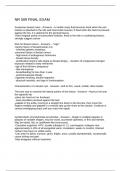NR 509 FINAL EXAM
Suspicious breast mass - Answers --A mobile mass that becomes fixed when the arm
relaxes is attached to the ribs and intercostal muscles; if fixed when the hand is pressed
against the hip, it is attached to the pectoral fascia.
-Hard irregular poorly circumscribed nodules, fixed to the skin or underlying tissues,
strongly suggest cancer
Risk for Breast cancer - Answers ---*Age*
-family history of breast/ovarian CA
- inherited genetic mutations,
-personal history of breast cancer
- high levels of endogenous hormones
- breast tissue density
- proliferative lesions with atypia on breast biopsy, - duration of unopposed estrogen
exposure related to early menarche
-age of first full-term pregnancy
- late menopause.
- breastfeeding for less than 1 year,
- postmenopausal obesity
-cigarette smoking, alcohol ingestion,
- physical inactivity, and type of contraception.
Characteristics of a breast cyst - Answers -Soft to firm, round, mobile, often tender.
The best way to examine the lateral portion of the breast - Answers --Have pt roll onto
the opposite hip
-place her hand on her forehead.
- keep shoulders pressed against the bed
-palpate in the axilla, moving in a straight line down to the bra line, then move the
fingers medially and palpate in a vertical strip up the chest to the clavicle. Continue in
vertical overlapping strips until you reach the nipple
Genital Warts (Condylomata Acuminata) - Answers --Single or multiple papules or
plaques of variable shapes; may be round, acuminate (pointed), or thin and slender.
May be raised, flat, or cauliflower-like (verrucous).
-Causative organism: HPV, usually subtypes 6, 11; carcinogenic subtypes rare,
approximately 5-10% of all anogenital warts. Incubation: weeks to months; infected
contact may have no visible warts.
-Can arise on penis, scrotum, groin, thighs, anus; usually asymptomatic, occasionally
cause itching and pain.
-May disappear without treatment.
, Risk for prostate CA - Answers -Age, ethnicity, and family history are the strongest risk
factors for prostate cancer.
s/s prostatitis - Answers --fever
-frequency, urgency, dysuria, incomplete voiding,
-sometimes low back pain
- gland feels tender, swollen, "boggy," and warm
s/s BPH - Answers -- irritative (urgency, frequency, nocturia),
-obstructive (decreased stream, incomplete emptying, straining), or both,
- gland may be normal in size, or may feel symmetrically enlarged, smooth, and firm,
though slightly elastic; there may be obliteration of the median sulcus and more notable
protrusion into the rectal lumen.
Measuring a pregnant uterus - Answers -With a plastic or paper tape measure, locate
the pubic symphysis and place the "zero" end of the tape measure where you can firmly
feel that bone (Fig. 19-12). Then extend the tape measure to the very top of uterine
fundus and note the number of centimeters measured.
s/s gestational HTN - Answers -systolic blood pressure (SBP) >140 mm Hg or diastolic
blood pressure (DBP) >90 mm Hg first documented after 20 weeks, without proteinuria
or preeclampsia, that resolves by 12 weeks postpartum.
s/s ectopic pregnancy - Answers --Abdominal pain
-adnexal tenderness
-abnormal uterine bleeding
how a Bartholin gland infection presents - Answers -Causes of a Bartholin gland
infection include trauma, gonococci, anaerobes like bacteroides and peptostreptococci,
and C. trachomatis. Acutely, the gland appears as a tense, hot, very tender abscess.
Look for pus emerging from the duct or erythema around the duct opening. Chronically,
a nontender cyst is felt that may be large or small.
Bleeding between periods - Answers -Metrorrhagia
Vaccines safe in pregnancy - Answers -pneumococcal, meningococcal, and hepatitis B.
Hepatitis A and B, meningococcal polysaccharide and conjugate, and pneumococcal
polysaccharide vaccines can be given, if indicated.
-inactivated influenza
-Tdap
When to give the tetanus vaccine - Answers -All adults aged ≥19 years, including those
aged ≥65 years: All adults aged ≥19 years who have not been vaccinated with Tdap
should receive a single dose of Tdap regardless of the time interval since last receiving
Td. After receiving Tdap, they should receive Td boosters at 10-year intervals. For




